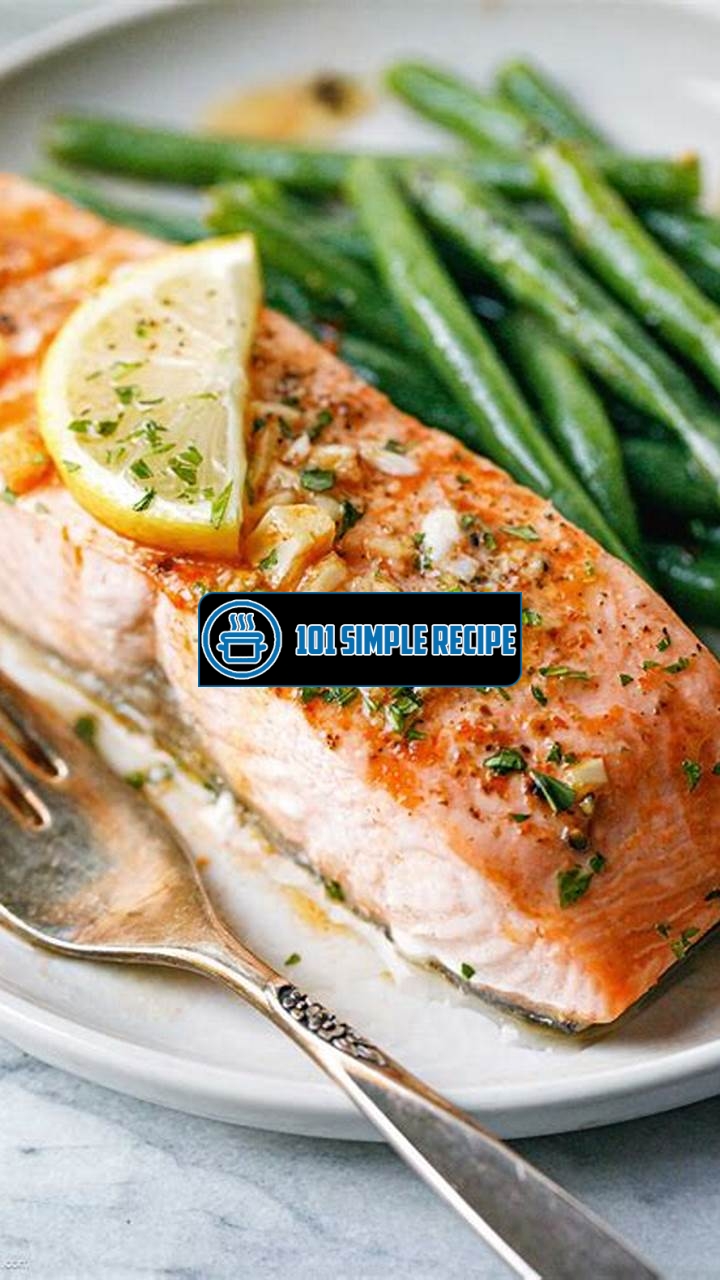Baking salmon in the oven is a mouthwatering way to prepare this nutritious and flavorful fish. Whether you’re a seafood enthusiast or simply looking to incorporate more Omega-3 fatty acids into your diet, this delicious and easy recipe will surely impress your taste buds. With just a few simple ingredients and minimal preparation time, you can create a stunning and healthy dish that will delight both family and guests. So, grab your apron and let’s learn how to bake salmon to perfection! ️

Salmon: A Delightful Oven-Baked Dish
Uncover the art of baking salmon to perfection and tantalize your taste buds with this exquisite dish.
Choosing the Perfect Salmon
When it comes to baking salmon in the oven, selecting the right type of salmon is crucial. The two most popular options are Atlantic salmon and Pacific salmon. Atlantic salmon is known for its mild and buttery flavor, while Pacific salmon varieties like Chinook, Coho, and Sockeye have a bolder and richer taste.
Preparing the Salmon for Baking
Before you start baking your salmon, it’s important to prepare it properly. Begin by preheating your oven to the recommended temperature, usually around 375°F (190°C). Next, ensure your salmon fillets are thawed if they were frozen. Pat them dry with a paper towel to remove excess moisture. This step is essential for achieving a crispy and flavorful crust on your salmon.
Now, let’s talk about the skin. While some people prefer to remove the skin before cooking, leaving it on has its benefits. The skin acts as a natural barrier, keeping the fish moist throughout the cooking process. If you decide to keep the skin on, make sure to score it with a sharp knife. This will prevent the fillet from curling up during cooking, ensuring even heat distribution.
Mastering the Art of Seasoning
Seasoning is where the magic happens when it comes to baking salmon in the oven. It’s important to strike the right balance between enhancing the natural flavors of the fish and overpowering it. A simple and classic combination is to season your salmon with salt, pepper, and a squeeze of lemon juice. The acidity from the lemon helps to cut through the richness of the fish and adds a refreshing tang.
If you’re feeling adventurous, you can experiment with different flavor profiles. Try adding fresh herbs like dill, thyme, or rosemary to the seasoning mix. These aromatic herbs infuse the salmon with incredible fragrance and taste. For a touch of sweetness, a drizzle of honey or maple syrup can work wonders.
To ensure the seasoning adheres well to the fish, you can brush the fillets with olive oil before sprinkling on your chosen herbs and spices. This not only helps with the flavor but also creates a beautiful golden crust when baked.
To achieve the perfect bake, place the seasoned salmon fillets on a lined baking sheet and cook them in the preheated oven. The cooking time will vary depending on the thickness of the fillets, but as a general rule, aim for about 12-15 minutes per inch of thickness. The salmon should be opaque and easily flake with a fork when it’s done.
In conclusion, baking salmon in the oven is a delightful way to showcase this delicious fish. By choosing the perfect salmon, preparing it correctly, and mastering the art of seasoning, you can create a flavorful and tender dish that will impress your family and friends. So, don’t hesitate to try out this easy recipe and enjoy a mouthwatering meal in the comfort of your own home.
Salmon Baking Techniques
Explore different baking techniques to achieve a succulent and flavorful result every time you cook salmon. Whether you prefer baking salmon in foil, on a cedar plank, or in a cast iron skillet, each method offers its unique advantages and can elevate the taste of this delicious fish.
Baking Salmon in Foil
Baking salmon in foil is a popular method that helps seal in the moisture and flavors. To prepare your salmon using this technique, start by preheating your oven to the desired temperature. Next, take a large piece of aluminum foil and fold it in half to create a sturdy double layer. Place the salmon fillet in the center of the foil and season it with your favorite herbs, spices, and a squeeze of lemon juice – it adds a refreshing citrusy taste. Then, carefully fold the foil over the salmon, ensuring all the edges are sealed tight to create a packet.
By baking the salmon in foil, you create a steaming effect that helps cook the fish evenly and keep it tender. Plus, it makes cleanup a breeze, as you can simply discard the foil after enjoying your meal.
Baking Salmon on a Cedar Plank
Baking salmon on a cedar plank infuses the fish with a delightful smoky flavor. Soak the cedar plank in water for at least one hour before using to prevent it from catching fire in the oven. This technique adds a unique touch to your salmon and creates a visually appealing presentation.
To prepare the salmon on a cedar plank, preheat your oven and place the soaked plank on a baking sheet. Season the salmon fillet with your preferred seasonings – a combination of dill, garlic, and a pinch of sea salt works wonders. Then, carefully place the salmon on the cedar plank and transfer it to the oven. As the salmon bakes, the cedar plank imparts a subtle woody aroma that enhances the taste.
Baking Salmon in a Cast Iron Skillet
Baking salmon in a cast iron skillet is ideal if you desire a crispy outer layer while keeping the interior moist and tender. Start by preheating your skillet in the oven to ensure even cooking. Coat the salmon fillet with a light layer of olive oil and season it with your desired spices. Place the salmon skin-side down in the heated skillet and let it cook for a few minutes until the skin becomes crispy. Then, transfer the skillet to the oven to finish baking the salmon to perfection.
The cast iron skillet provides excellent heat distribution, allowing the salmon to cook evenly and creating a beautifully seared crust. It’s a fantastic option for those who enjoy a contrast in textures.
Whether you choose to bake salmon in foil, on a cedar plank, or in a cast iron skillet, these techniques will undoubtedly elevate your culinary skills and impress your dinner guests. The key is to experiment with different flavors and seasonings to find your favorite method for baking salmon in the oven. Happy cooking!
Enhancing Flavors with Marinades and Glazes
When it comes to baking salmon in the oven, one of the easiest and most delicious ways to elevate its flavor is by using marinades and glazes. These secret ingredients can transform a simple piece of salmon into a mouthwatering dish that will have your taste buds dancing with delight. In this article, we will explore three delectable recipes for marinades and glazes that are sure to take your baked salmon to new heights.
Savory Soy-Ginger Marinade
If you are looking for a savory and umami-packed flavor profile for your baked salmon, look no further than the soy-ginger marinade. This versatile marinade combines the rich flavors of soy sauce, fresh ginger, garlic, and a touch of brown sugar for the perfect balance of savory and sweet. To prepare this marinade, simply whisk together soy sauce, minced ginger, minced garlic, brown sugar, and a dash of sesame oil. Allow your salmon to marinate in this fragrant mixture for at least 30 minutes to infuse the flavors. When baked in the oven, the salmon will absorb the marinade, resulting in a tender and flavorful dish that is sure to impress.
Sweet and Tangy Honey Mustard Glaze
If you prefer a sweet and tangy flavor profile, the honey mustard glaze is the perfect choice for your baked salmon. This glaze combines the sweetness of honey with the tanginess of mustard, creating a delightful harmony of flavors. To make this glaze, simply mix together honey, Dijon mustard, lemon juice, and a pinch of garlic powder. Brush the glaze onto your salmon before baking and allow it to caramelize in the oven. The result is a succulent piece of salmon with a sticky and irresistible glaze that will leave you craving for more.
Refreshing Lemon Herb Marinade
If you prefer a lighter and more refreshing flavor for your baked salmon, the lemon herb marinade is the way to go. This marinade showcases the bright and zesty flavors of lemon and herbs, creating a vibrant and refreshing dish. To create this marinade, combine freshly squeezed lemon juice, minced garlic, chopped fresh herbs such as dill and parsley, olive oil, salt, and pepper. Allow the salmon to marinate in this mixture before baking to infuse it with the invigorating flavors. When cooked, the salmon will have a tangy and herbaceous taste that is perfect for those who enjoy a burst of freshness in every bite.
So why settle for plain and boring baked salmon when you can enhance its flavors with these fantastic marinades and glazes? Whether you choose the savory soy-ginger marinade, the sweet and tangy honey mustard glaze, or the refreshing lemon herb marinade, your taste buds are in for a treat. Experiment with these recipes and unleash your creativity in the kitchen. Your guests and loved ones will be impressed with your culinary skills, and you will have a new go-to recipe for baking salmon in the oven. Happy cooking!
Optimal Baking Temperatures and Times
When it comes to baking salmon in the oven, understanding the importance of temperature and time is crucial to achieve a perfectly cooked piece of fish that simply melts in your mouth. Cooking salmon to perfection requires careful attention to these two factors. In this article, we will dive into the ideal temperature for baked salmon, guidelines for cooking times based on thickness, and a foolproof method to test for doneness.
The Ideal Temperature for Baked Salmon
Choosing the right temperature is essential to ensure that your salmon turns out moist and flavorful. The ideal temperature for baking salmon in the oven is 375 degrees Fahrenheit (190 degrees Celsius). At this temperature, the salmon cooks evenly and retains its natural juices, resulting in a tender and succulent final dish.
The concept of cooking salmon at a lower temperature for a longer time may seem tempting, as it is often associated with achieving a more tender texture. However, it is important to keep in mind that overcooking can lead to dry and rubbery salmon. Therefore, it is advisable to stick to the recommended temperature and cooking time for the best results.
Guidelines for Cooking Times Based on Thickness
The thickness of your salmon fillet plays a significant role in determining the cooking time. To ensure that your salmon is cooked to perfection, follow these general guidelines:
- For salmon fillets that are approximately 1 inch (2.5 cm) thick, bake them for about 12 to 15 minutes. This will result in a moist and slightly pink center.
- If your salmon fillet is thicker, around 1.5 inches (3.8 cm), increase the baking time to 18 to 20 minutes. This will allow the heat to penetrate the thicker piece of fish more effectively.
- On the other hand, if you have a thinly sliced salmon fillet that is less than 1 inch (2.5 cm) thick, reduce the cooking time to 8 to 10 minutes. This will prevent the salmon from becoming overcooked and dry.
Remember to always keep an eye on the salmon towards the end of the suggested cooking time to avoid any potential overcooking.
Testing for Doneness: A Foolproof Method
Testing for doneness is the key to ensuring that your salmon is perfectly cooked and ready to be enjoyed. One foolproof method is to use a fork to gently flake the flesh of the salmon. The fish should easily separate into moist and translucent flakes.
Another useful technique is to insert an instant-read thermometer into the thickest part of the salmon. The internal temperature should reach 145 degrees Fahrenheit (63 degrees Celsius) for the salmon to be considered fully cooked.
Note: Ensure that the thermometer does not touch the bone, as this might affect the accuracy of the reading.
By following these guidelines and using the foolproof testing methods mentioned, you can confidently bake salmon in the oven to perfection every time. Remember, the optimal temperature and cooking time may vary slightly depending on the thickness of your salmon fillet, so adjust accordingly for the best results. Enjoy a delicious and easy-to-make salmon dish that will impress your taste buds and leave you craving for more!
Baking sliders White Castle recipe
Serving Suggestions and Pairings
When it comes to serving baked salmon, there are endless possibilities for delightful sides and sauces that can complement and elevate the flavors of this delicious dish. Whether you are hosting a dinner party or simply enjoying a meal at home, the right pairings can take your oven-baked salmon to the next level. Let’s explore some simple side dishes, delectable sauces, and wine pairing recommendations that will enhance your culinary experience.
Simple Side Dishes that Complement Baked Salmon
Pairing your baked salmon with the right side dish can make all the difference in terms of taste and texture. Here are some simple side dishes that perfectly complement oven-baked salmon:
- Roasted Vegetables: Emoji:
- Quinoa Pilaf: Emoji:
- Steamed Green Beans: Emoji:
Roasted vegetables such as asparagus, Brussels sprouts, or carrots add a delightful crunch and earthy flavor to your salmon. Simply toss them in olive oil, sprinkle with salt and pepper, and roast them in the oven alongside your fish.
Quinoa is a nutritious and versatile grain that pairs beautifully with oven-baked salmon. Prepare a pilaf by cooking quinoa in vegetable broth and adding sautéed onions, garlic, and your favorite herbs.
A light and refreshing side dish, steamed green beans add a pop of color and freshness to your plate. Steam the beans until they are tender-crisp and toss them with a drizzle of lemon juice and a sprinkle of sea salt.
Delectable Sauces to Elevate the Flavor
If you want to take your baked salmon to the next level, consider adding a delectable sauce that complements its flavors. Here are a few sauce options that will enhance the taste of your oven-baked salmon:
- Lemon Dill Sauce: Emoji:
- Garlic Butter Sauce: Emoji:
- Spicy Mango Salsa: Emoji: ️
A classic choice, a creamy lemon dill sauce adds a tangy and herbaceous touch to your salmon. Combine mayonnaise, lemon juice, fresh dill, and a pinch of salt to create this flavorful sauce.
Indulge your taste buds with a rich and savory garlic butter sauce. Melt butter in a saucepan, add minced garlic, and cook until fragrant. Drizzle this decadent sauce over your oven-baked salmon to add a burst of flavor.
If you’re looking for a unique twist, try a spicy mango salsa. Combine diced mango, red bell pepper, red onion, jalapeño, fresh cilantro, lime juice, and a pinch of cayenne pepper for a sweet and spicy topping.
Wine Pairing Recommendations for Baked Salmon
To complete your dining experience, selecting the right wine to pair with your baked salmon is essential. Here are some wine pairing recommendations that will harmonize with the flavors of your oven-baked salmon:
- Chardonnay: Emoji:
- Sauvignon Blanc: Emoji:
- Pinot Noir: Emoji:
A buttery and full-bodied Chardonnay complements the richness of baked salmon. The creamy texture and tropical fruit flavors of the wine enhance the flavors of the fish.
If you prefer a lighter wine, opt for a Sauvignon Blanc. Its crisp acidity and citrusy notes provide a refreshing contrast to the richness of the salmon.
For those who enjoy red wine, a light and fruity Pinot Noir is an excellent choice. It offers flavors of red berries that complement the flavors of the fish without overpowering them.
With these serving suggestions and pairings, you can create a memorable dining experience centered around your oven-baked salmon. Whether you choose to prepare simple side dishes, whip up delectable sauces, or select the perfect wine, these complementary elements will enhance the flavors of your dish and impress your guests. Get ready to savor every bite of your perfectly cooked salmon!
Thank you for taking the time to read our article on baking salmon in the oven. We hope you found the information helpful and inspiring for your next culinary adventure. If you’re craving delicious, tender salmon with a crispy exterior, look no further than your trusty oven. Salmon is not only packed with nutrients, but it’s also versatile and easy to prepare. So whether you’re a seasoned chef or a beginner in the kitchen, baking salmon in the oven is a foolproof way to create a flavorful and healthy meal. Don’t forget to bookmark our page and visit us again for more amazing recipes and cooking tips!
Frequently Asked Questions
Here are some common questions about baking salmon in the oven:
| No. | Questions | Answers |
|---|---|---|
| 1. | How long should I bake salmon in the oven? | The cooking time may vary depending on the thickness of your salmon fillet. As a general rule, bake salmon in a preheated oven at 425°F (220°C) for about 12-15 minutes per inch of thickness. The salmon should flake easily with a fork and have an internal temperature of 145°F (63°C) when fully cooked. |
| 2. | Can I marinate salmon before baking? | Absolutely! Marinating salmon before baking can infuse it with incredible flavors. You can use a variety of marinades such as citrus, teriyaki, or herbs and spices. Simply place the salmon fillets in a shallow dish, add the marinade, and let it sit in the refrigerator for at least 30 minutes before baking. |
| 3. | Should I leave the skin on or remove it before baking? | That’s entirely up to your preference! Leaving the skin on can help protect the delicate flesh of the salmon and keep it moist during baking. It also adds a nice crispness to the finished dish. However, if you prefer skinless fillets, you can easily remove the skin using a sharp knife before baking. |
| 4. | What seasonings go well with salmon? | Salmon pairs well with a wide range of seasonings. Some popular choices include dill, lemon, garlic, honey, soy sauce, and herbs like thyme or rosemary. Feel free to experiment with your favorite flavors and create your own signature seasoning blend. |
| 5. | Can I bake frozen salmon? | Yes, you can bake frozen salmon without thawing it first. Simply increase the baking time by about 5-7 minutes. It’s important to note that frozen salmon may release more moisture during baking, so make sure to pat it dry with a paper towel before seasoning and placing it in the oven. |
| 6. | What side dishes pair well with baked salmon? | Baked salmon pairs perfectly with a variety of side dishes. Some popular options include roasted vegetables, steamed asparagus, quinoa salad, mashed potatoes, or a fresh green salad. The possibilities are endless, so choose your favorite sides to complement your baked salmon. |
Baked Salmon in the Oven Recipe
Here’s a simple and delicious recipe for baking salmon in the oven:
Jump to Recipe
Baked Salmon in the Oven

Learn how to perfectly bake salmon in the oven to achieve a tender and flavorful dish.
- 4 salmon fillets
- 2 tablespoons olive oil
- 1 tablespoon lemon juice
- 2 cloves garlic (minced)
- 1 teaspoon dried dill
- Salt and pepper to taste
- Preheat the oven to 425°F (220°C).
- In a small bowl, mix together the olive oil, lemon juice, minced garlic, dried dill, salt, and pepper.
- Place the salmon fillets on a baking sheet lined with parchment paper.
- Brush the top of each salmon fillet with the prepared marinade.
- Bake in the preheated oven for 12-15 minutes or until the salmon flakes easily with a fork.
- Serve hot and enjoy!






